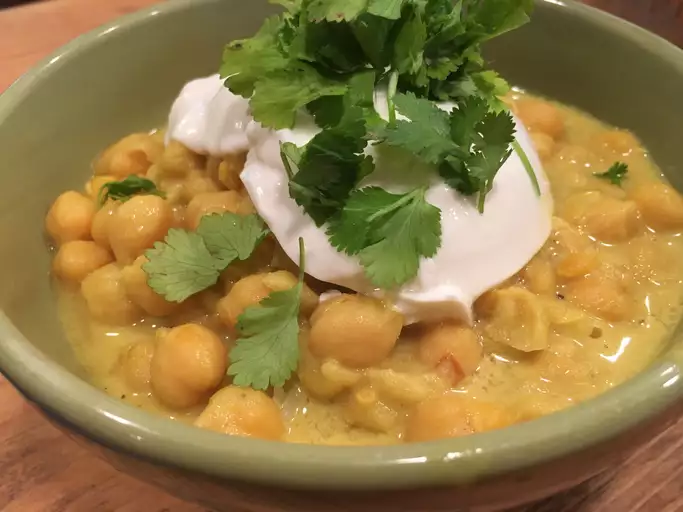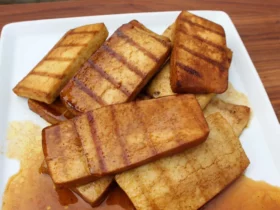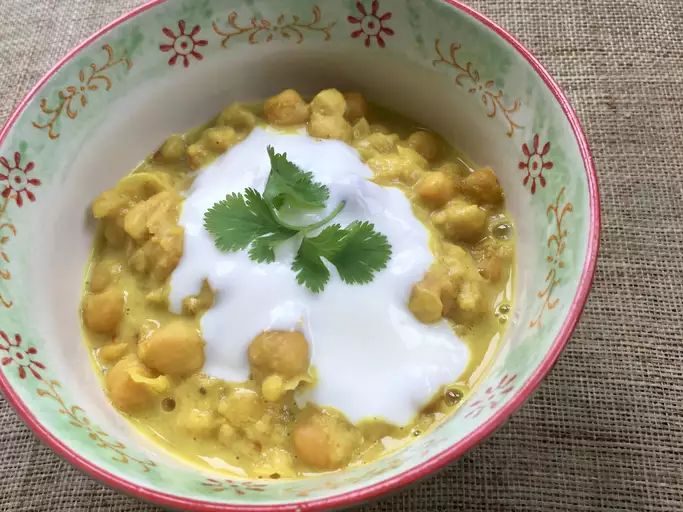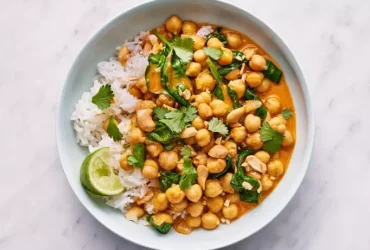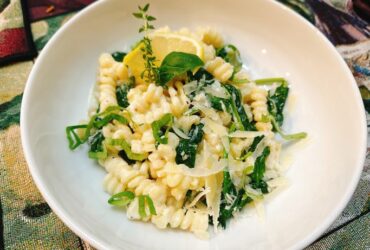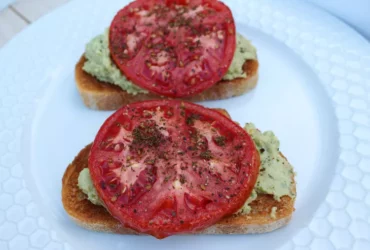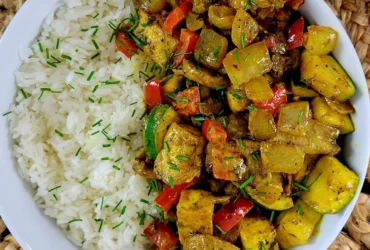Ingredients
Coconut-based Curry Sauce
The key to a delicious and authentic-tasting coconut-based curry sauce lies in the selection of high-quality ingredients. Here are some essential elements to include in your clean-eating coconut chickpea curry recipe:
Main Ingredients
- Avg 2 cups mixed veggies, such as onions, bell peppers, carrots, and potatoes
- 1 can (15 oz) chickpeas, drained and rinsed
- 3 tablespoons coconut oil
Spices and Seasonings
- 2 teaspoons ground cumin
- 1 teaspoon turmeric powder
- 1 teaspoon curry powder
- 1/2 teaspoon paprika
- Salt and pepper, to taste
- Avg 1 tablespoon grated fresh ginger
- Avg 2 cloves garlic, minced
Creamy Coconut Sauce
- 1 can (14 oz) full-fat coconut milk
- 2 tablespoons coconut cream or plain Greek yogurt
- 2 tablespoons freshly squeezed lime juice
Natural Thickening Agent
- 1 tablespoon arrowroot powder or cornstarch (optional)
When selecting coconut products, choose unsweetened and unflavored options to maintain the clean-eating integrity of your recipe.
1 can (14 oz) fullfat coconut milk
When it comes to making a delicious and healthy Clean-Eating Coconut Chickpea Curry, one of the key ingredients that sets this dish apart from other curries is the use of full-fat coconut milk.
The can of 14 oz full-fat coconut milk is a staple in many Asian and Indian recipes, and for good reason. The high fat content of the coconut milk adds richness and creaminess to the curry sauce, making it feel indulgent and satisfying without any added dairy products or oils.
Coconut milk is made by grating the flesh of mature coconuts and soaking it in hot water to extract the creamy liquid. The resulting product has a rich, velvety texture and a mild flavor that complements the spices and other ingredients in the curry without overpowering them.
The high fat content of full-fat coconut milk is also what gives it its versatility in cooking. It can be used as a substitute for heavy cream or half-and-half in many recipes, adding moisture and richness to sauces, soups, and curries.
In the context of the Clean-Eating Coconut Chickpea Curry Recipe, the full-fat coconut milk is used to create a creamy and indulgent curry sauce that coats the chickpeas and other vegetables without any added dairy products or oils. This makes it a great option for anyone who wants to enjoy a delicious and healthy curry without compromising on flavor.
When choosing a can of 14 oz full-fat coconut milk, look for one that is unflavored and unsweetened. Some brands may add flavorings or sweeteners to their coconut milk, which can affect the flavor of your curry. It’s also worth noting that some brands may use BPA-lined cans, so be sure to check the packaging before making a purchase.
In terms of substitutions, it’s worth noting that you can use low-fat or non-fat coconut milk as a substitute in a pinch. However, keep in mind that this will affect the richness and creaminess of the curry sauce. If you’re looking for a lower-calorie option, you can also try using Greek yogurt or cottage cheese to add moisture and flavor to your curry.
In summary, full-fat coconut milk is an essential ingredient in many Asian and Indian recipes, including the Clean-Eating Coconut Chickpea Curry Recipe. Its high fat content adds richness and creaminess to sauces, soups, and curries without any added dairy products or oils, making it a great option for anyone looking to enjoy a healthy and delicious curry.
1/4 cup coconut oil
The key to a delicious and authentic Coconut Chickpea Curry lies in the selection of high-quality ingredients.
For this recipe, you will need:
- 1/4 cup coconut oil
- One medium onion, finely chopped
- Two cloves of garlic, minced
- A 15-ounce can of chickpeas, drained and rinsed
- One teaspoon of ground cumin
- One teaspoon of curry powder
- A pinch of salt and pepper to taste
- 1/4 cup of coconut milk or plain Greek yogurt (optional)
- Fresh cilantro leaves, for garnish
The star ingredient in this recipe is the coconut oil, which adds a rich and creamy texture to the curry.
The high smoke point of coconut oil makes it an ideal choice for sautéing aromatics like onions and garlic without breaking down or smoking.
You can find virgin coconut oil in most health food stores or online, and use it to add a distinct flavor and aroma to your curry.
To incorporate the coconut oil into your recipe, start by heating 1/4 cup of coconut oil in a large skillet over medium heat.
The core ingredients that bring this Clean-Eating Coconut Chickpea Curry to life include:
Chickpeas: These versatile legumes are rich in protein and fiber, making them a staple in many plant-based diets.
Coconut oil or coconut milk: A key component in this recipe, coconut adds a creamy texture and subtle flavor that complements the spices.
Onions, garlic, and ginger: These aromatic ingredients form the foundation of many Indian-inspired dishes, providing depth and warmth to the curry.
Cumin, cayenne pepper, and coriander powder: A blend of these spices creates a balanced flavor profile that’s both earthy and aromatic.
Tomatoes or tomato paste: Fresh or cooked tomatoes add natural sweetness and help to thicken the curry sauce.
Lime juice and fresh cilantro: A squeeze of lime and a sprinkle of fresh cilantro add a burst of citrus flavor and freshness.
Salt and black pepper: Used in moderation, these seasonings enhance the overall flavor without overpowering the other ingredients.
This carefully selected combination of ingredients not only creates a delicious and nutritious curry but also demonstrates the beauty of using whole foods as the building blocks of a healthy meal plan.
Main Course
The main course of our Clean-Eating Coconut Chickpea Curry Recipe consists of several essential ingredients that come together to create a delicious and nutritious dish.
First, we have chickpeas, which are an excellent source of plant-based protein and fiber. They add a creamy texture and a nutty flavor to the curry.
Rice is another crucial ingredient in this recipe, providing complex carbohydrates for sustained energy and supporting digestive health. Brown rice, in particular, is a good option as it’s higher in fiber and nutrients compared to white rice.
The coconut milk serves as a rich and creamy base for the curry, adding a subtle sweetness and a boost of healthy fats. It also helps to balance out the spiciness from the other ingredients.
A variety of spices are used in this recipe, including turmeric, cumin, coriander, cinnamon, and cardamom. These spices provide an array of health benefits, such as anti-inflammatory properties and antioxidant activity.
The use of coconut oil or olive oil is also essential in this recipe, providing a healthy source of fat for energy production and supporting heart health.
Finally, we have a variety of aromatics like onions, ginger, and garlic, which add depth and flavor to the curry while providing additional health benefits such as reducing inflammation and boosting immune function.
Together, these ingredients come together to create a nourishing and delicious Clean-Eating Coconut Chickpea Curry that is perfect for a weeknight dinner or a special occasion meal.
The combination of protein-rich chickpeas, complex carbohydrates from brown rice, and healthy fats from coconut milk makes this dish an excellent option for those following a clean-eating lifestyle.
1 can (15 oz) chickpeas, drained and rinsed
Chickpeas are a key ingredient in this Clean-Eating Coconut Chickpea Curry Recipe, and using canned chickpeas can be a convenient and nutritious option.
A single 15 oz can of chickpeas contains approximately 1 cup or 200g of drained and rinsed chickpeas.
Chickpeas are high in protein, fiber, and various essential nutrients such as potassium, zinc, iron, and folate, making them a great addition to this curry recipe.
Rinsing the chickpeas after draining helps remove excess sodium from the canning process and gives them a cleaner taste profile.
Chickpeas have a mild, nutty flavor that pairs well with the rich coconut milk and aromatic spices used in this recipe, allowing their neutral flavor to blend in seamlessly without overpowering the other ingredients.
When selecting canned chickpeas, look for brands that are low-sodium or no-added-salt options to minimize added sodium intake.
Canned chickpeas can be easily substituted with cooked dried chickpeas, but this requires more time and preparation; simply cooking them according to package instructions will yield similar nutritional benefits as the canned variety.
1 large onion, diced
A single large onion can be quite substantial, but it’s perfect for this recipe as we’ll be using it as a base for our aromatic foundation.
Dice the onion into small, uniform pieces, about 1/4 inch in size. This will ensure that the onions cook evenly and quickly, releasing their natural sweetness and depth of flavor into the curry sauce.
It’s worth noting that using a large onion can result in a slightly stronger flavor than if you were to use a smaller one or multiple smaller onions. However, this is not necessarily a bad thing, as it will add richness and complexity to our Clean-Eating Coconut Chickpea Curry Recipe.
Making sure each piece of the diced onion is relatively even in size also helps with the cooking process, ensuring that everything cooks at roughly the same rate, resulting in a perfectly balanced flavor profile when combined with the other ingredients in this recipe.
The ingredients required for this Clean-Eating Coconut Chickpea Curry recipe are as follows:
You will need:
- 1 can chickpeas, drained and rinsed (look for low-sodium or no-added salt option)
- 2 medium onions , diced
- 3 cloves of garlic , minced
- 1 tablespoon of olive oil
- 1 teaspoon of ground cumin
- 1 teaspoon of turmeric powder
- 1/2 teaspoon of cayenne pepper (optional, adjust to taste)
- 1 can (14 oz) of full-fat coconut milk
- 1 cup of brown chicken or vegetable broth, low-sodium
- Fresh cilantro leaves for garnish
For the Coconut Milk , you can use full-fat, low-sodium canned version. Make sure to check the label and choose a brand with minimal added ingredients.
Please note that the ingredient list is subject to change based on personal preferences and dietary requirements. Feel free to adjust or substitute ingredients as needed to suit your taste and nutritional needs.
Instructions and Tips
Searing the Onion and Garlic
To achieve the best flavor in our Clean-Eating Coconut Chickpea Curry Recipe, it’s essential to properly sear the onion and garlic before adding other ingredients.
Instructions for Searing Onion and Garlic
Step 1: Prepare the Ingredients
- Select a medium-sized onion and 3-4 cloves of garlic, depending on your desired intensity of flavor.
- Peel the onion and mince it. Mince the garlic as well.
- Mise en place: have all your ingredients ready before starting to cook.
Step 2: Heat Oil in a Pan
- In a large pan, heat 1-2 tablespoons of oil over medium-high heat. You can use coconut oil or any other neutral-tasting oil.
Step 3: Sear the Onion and Garlic
- Add the minced onion to the pan first. Stir occasionally until it starts browning (about 3-4 minutes).
- Once the onion is lightly browned, add the garlic and continue stirring for another minute or two.
Tips to Ensure Perfectly Searred Onion and Garlic
- Stir the pan frequently to avoid burning either the onion or garlic. You can also stir in a circular motion, making sure not to leave any large chunks unattended.
- Don’t overcrowd the pan; cook the onion and garlic in batches if necessary.
Benefits of Searing Onion and Garlic
- The Maillard reaction, a chemical reaction that occurs when food is cooked, produces new flavor compounds. This process enhances the taste and aroma of your dish.
- A properly seared onion adds a depth of flavor and texture to your curry that raw onions simply can’t match.
Remember, practice makes perfect. Experiment with different cooking techniques to achieve the best results for your Clean-Eating Coconut Chickpea Curry Recipe!
Heat 2 tablespoons of coconut oil in a pan over medium heat.
To prepare this delicious and nutritious Clean-Eating Coconut Chickpea Curry, it’s essential to follow these steps carefully.
Step 1: Heat the Coconut Oil
- Heat 2 tablespoons of coconut oil in a pan over medium heat. This will help to add flavor and moisture to your curry.
- Allow the oil to melt completely, which should only take a minute or two. Stir occasionally to prevent it from burning.
Step 2: Sauté the Aromatics
- Add 1 small onion, finely chopped, and sauté until it’s translucent. This will add a sweet and caramelized flavor to your curry.
- Next, add 2 cloves of garlic, minced, and cook for another minute until fragrant.
Step 3: Add the Curry Spices
- Add 1 teaspoon of ground cumin, 1 teaspoon of curry powder, and 1/2 teaspoon of turmeric to the pan. Stir well to combine with the oil and aromatics.
- Cook for about a minute until the spices are fragrant and the mixture is well coated.
Step 4: Add the Coconut Milk and Chickpeas
- Pour in 1 can of full-fat coconut milk and stir to combine with the spice mixture.
- Add 1 can of chickpeas, drained and rinsed, to the pan. Stir gently to avoid breaking the chickpeas.
Step 5: Simmer the Curry
- Cook the curry over medium-low heat for about 20-25 minutes or until it thickens slightly.
- Stir occasionally to prevent the curry from sticking to the pan. Season with salt and pepper to taste.
Step 6: Serve and Enjoy!
- Transfer the Clean-Eating Coconut Chickpea Curry to a serving dish or individual bowls.
- Garnish with chopped fresh cilantro, scallions, or other herbs of your choice. Serve over brown rice or with naan bread for a delicious and satisfying meal!
Mince 2 cloves of garlic and add to the pan with the onion.
To create a flavorful and aromatic coconut chickpea curry, it’s essential to follow these instructions carefully.
When mincing garlic for this recipe, it’s best to use fresh and high-quality cloves. Choose two good-sized ones from the bunch, as they will yield the most flavor when cooked.
Begin by placing the garlic on a cutting board, positioning them with their root ends facing downwards. This orientation will help you maintain control over the knife and prevent accidental rolling or shifting during the mincing process.
Carefully hold one of the cloves firmly in place with your fingers, applying gentle pressure to keep it stable. Position the tip of a sharp chef’s knife on the center of the clove at a slight angle, roughly 20 degrees from vertical.
With a smooth, light touch, make a gentle rocking motion with your hand, guiding the blade in a small circle through the center of the clove. Apply gentle downward pressure as you move the blade through the garlic, taking care not to apply too much force and risk crushing or tearing the flesh.
This process should yield about half an inch of minced garlic from each clove, depending on their size and quality. You can store any leftover minced garlic in airtight containers in the refrigerator for later use in other recipes.
Now that you have your minced garlic ready to add to the pan, heat a couple of tablespoons of oil or ghee over medium-low heat until it reaches its smoky aroma stage, but don’t let it smoke. Once hot, carefully pour in the minced garlic and cook for about 30 seconds or until fragrant.
Add your chopped onions to the pan with the cooked garlic and proceed with sautéing them until they turn translucent, taking care not to burn the garlic. Continue cooking the aromatics as instructed in the recipe to achieve the perfect coconut chickpea curry flavor and texture.
To make this delicious Clean-Eating Coconut Chickpea Curry Recipe, follow these instructions and tips carefully:
Ingredients: Make sure to have all the necessary ingredients ready before starting to cook. The recipe requires:
- 1 can chickpeas (drained and rinsed)
- 2 tablespoons coconut oil
- 1 onion, diced
- 2 cloves garlic, minced
- 1 tablespoon grated fresh ginger
- 1 teaspoon ground cumin
- 1 teaspoon curry powder
- 1/2 teaspoon turmeric powder
- 1/4 teaspoon cayenne pepper (optional)
- 1 can full-fat coconut milk
- 2 cups vegetable broth (low-sodium)
- Salt, to taste
- Fresh cilantro leaves, for garnish
Instructions: Follow these steps to prepare the Clean-Eating Coconut Chickpea Curry Recipe
- In a large saucepan, heat the coconut oil over medium heat.
- Add the diced onion and sauté until it is translucent, about 3-4 minutes.
- Next, add the minced garlic and grated ginger. Cook for another minute, stirring constantly to prevent burning.
- Mix in the cumin, curry powder, turmeric powder, and cayenne pepper (if using). Stir well for about 1-2 minutes, allowing the spices to infuse into the oil.
- Add the chickpeas, coconut milk, and vegetable broth. Stir gently to combine, then bring the mixture to a simmer.
- Reduce heat to low and let the curry cook for about 20-25 minutes or until it thickens slightly. Season with salt to taste.
- Garnish with fresh cilantro leaves and serve over rice, quinoa, or as part of a meal bowl.
Preparation Tips: To make the most out of this recipe
- Makes sure to use full-fat coconut milk for the best flavor and creaminess.
- Select a low-sodium vegetable broth or adjust according to taste.
- Customize the spice level by adjusting the amount of cayenne pepper or omitting it altogether.
- Feel free to add other vegetables, like bell peppers, carrots, or potatoes, to suit your preferences.
This Clean-Eating Coconut Chickpea Curry Recipe makes a delicious and nutritious meal that’s perfect for busy days. The combination of chickpeas, coconut milk, and spices creates a rich and creamy sauce with plenty of protein and fiber.
Preparing the Coconut Curry Sauce
To prepare a delicious and authentic Coconut Curry Sauce for your Clean-Eating Coconut Chickpea Curry Recipe, follow these instructions and tips:
Choosing the Right Ingredients
- Select high-quality, fresh coconuts for the best flavor.
- Pick a mix of spices that include cumin, coriander, turmeric, and red pepper flakes for an authentic taste.
- Select a variety of vegetables such as carrots, potatoes, and bell peppers to add texture and flavor.
Gathering the Necessary Tools
- Use a coconut grater or food processor to grate fresh coconuts.
- A blender or food processor is necessary for making the curry sauce smooth and creamy.
- Select a large pot with a heavy bottom, such as a Dutch oven, to cook the sauce.
Preparing the Coconut Curry Sauce
- Melt 2 tablespoons of oil in a pan over medium heat. Add 1 teaspoon of cumin seeds and let them sizzle for 10 seconds.
- Add 1 small onion, finely chopped, to the pan and sauté until it is translucent and fragrant.
- Mix in 2 cloves of minced garlic and cook for another minute.
- Add 1 cup of grated coconut, 1 tablespoon of curry powder, and 1 teaspoon of turmeric. Mix well and cook for about 2-3 minutes or until the mixture is fragrant.
- Pour in 2 cups of water and bring the mixture to a boil. Reduce the heat to low and simmer for about 15-20 minutes or until the sauce thickens.
Finishing Touches
- Add salt, sugar, and cayenne pepper according to your taste preferences.
- Pour in 1 cup of coconut milk and stir well. Let the sauce simmer for another 5-7 minutes or until it thickens slightly.
- Taste and adjust the seasoning as needed.
Now, serve the delicious Coconut Curry Sauce over cooked chickpeas, rice, or vegetables for a nutritious and flavorful meal.
In a blender, combine
To prepare this Clean-Eating Coconut Chickpea Curry Recipe, start by gathering all the necessary ingredients and equipment. Here are some instructions and tips to help you along the way:
Gather Ingredients:
In a blender, combine the following ingredients:
1 can (14 oz) diced tomatoes
1/4 cup fresh cilantro leaves
2 cloves garlic, peeled and chopped
1-inch piece of fresh ginger, peeled and chopped
1 tablespoon coconut oil
1 teaspoon ground cumin
1 teaspoon curry powder
Salt and pepper to taste
Prep the Chicken or Tofu (optional):
If you choose to include protein in your curry, cut 1 pound boneless, skinless chicken breast or 3/4 cup extra-firm tofu into bite-sized pieces. Season with salt and pepper to taste.
Blend the Curry Paste:
In a blender or food processor, blend all the ingredients until smooth. Stop occasionally to scrape down the sides of the blender to ensure everything is well mixed.
Heat the Oil in the Pan:
In a large saucepan, heat 2 tablespoons coconut oil over medium-high heat. Add the chicken or tofu (if using) and cook until browned on both sides and cooked through.
Add the Curry Paste and Canned Coconut Milk:
- Pour the blended curry paste into the pan with the chicken or tofu (if using). Stir to combine, then add 1 can (14 oz) full-fat coconut milk. Stir to combine.
Bring to Simmer:
- Bring the mixture to a simmer and let cook for 10-15 minutes or until the sauce has thickened slightly.
Add Chickpeas and Seasoning:
- Stir in 1 cup cooked chickpeas and season with salt, pepper, and additional curry powder (if desired).
Taste and Adjust:
- Taste and adjust the seasoning as needed. If it’s too thick, add a little water. If it’s too thin, simmer for another 5-10 minutes.
Serve and Enjoy:
- Serve hot over rice or with naan bread. Garnish with chopped cilantro, if desired.
Tips and Variations:
- To make this recipe vegan, omit the chicken or tofu and use additional chickpeas.
- For a creamier curry, add 1-2 tablespoons coconut cream (optional).
- If using fresh herbs like cilantro or basil, add them towards the end of cooking to preserve their flavor and aroma.
Clean-Eating Tips:
- To make this recipe cleaner, be sure to choose full-fat coconut milk and avoid added sugars. Opt for low-sodium broth or stock if using.
1/4 cup coconut milk
The beauty of cooking lies in its ability to be customized to individual tastes and dietary needs, making it an incredibly personal experience. When following a recipe like the Clean-Eating Coconut Chickpea Curry Recipe, understanding the importance of certain ingredients and their measurements is crucial for achieving the desired outcome.
In this case, the recipe calls for 1/4 cup coconut milk, which may seem like a small amount but plays a significant role in the overall flavor and texture of the dish. To put this measurement into perspective, a standard can of full-fat coconut milk is usually around 14 oz or 400 ml, meaning that 1/4 cup is roughly equivalent to about 2 tablespoons.
So why is 1/4 cup coconut milk so important in this recipe? First and foremost, it provides a rich source of creaminess without adding any refined sugars or heavy ingredients. Coconut milk contains medium-chain triglycerides (MCTs), which are easily absorbed by the body and provide sustained energy.
Using 1/4 cup coconut milk also allows for a delicate balance of flavors in the curry, preventing it from becoming too rich or overpowering. By incorporating just the right amount of creaminess, you can achieve a harmonious blend of spices, herbs, and vegetables that will leave your taste buds singing.
Now, let’s talk about how to measure out 1/4 cup coconut milk effectively. When measuring liquids, it’s essential to use a dry measuring cup or a liquid measuring cup with clear markings. Pour the coconut milk into the measuring cup, making sure not to overfill it, and then level off the excess with a straight edge or knife.
Alternatively, you can also use the ‘spoon method’ for measuring liquids by scooping 2-3 tablespoons of coconut milk into a small bowl or ramekin. This method is more forgiving than using a liquid measuring cup but requires some practice to get it right.
In conclusion, incorporating 1/4 cup coconut milk into your Clean-Eating Coconut Chickpea Curry Recipe is crucial for achieving the perfect balance of flavors and textures. By understanding the importance of this measurement and mastering the art of measuring liquids effectively, you’ll be well on your way to creating a truly exceptional dish that will delight your senses.
To make this delicious Clean-Eating Coconut Chickpea Curry Recipe, follow these instructions and tips:
Preparation
- Preliminary preparation is crucial to a successful cooking process.
- Making sure you have all the ingredients ready beforehand will save you time in the long run.
Ingredients and Substitutions
- Make a note of the ingredients needed for the recipe, as listed below. This will ensure that you don’t forget any essential items during shopping or preparation.
- Some ingredients, such as coconut milk, can be substituted with alternative options. For instance, you can use full-fat canned coconut milk instead of the freshly opened can if you cannot find it in your local stores.
Cooking Tips
- When cooking the onion and ginger mixture, ensure they are well-browned before adding the spices. This will bring out their natural sweetness and depth of flavor.
- Avoid overcooking the chickpeas by cooking them until tender but not mushy. Stir-frying them for a few minutes after adding the coconut milk helps achieve this texture.
Customization
- This recipe is a versatile base that can be tailored to suit your taste preferences and dietary requirements.
- Consider adding or substituting different spices, herbs, or vegetables according to your liking. For instance, you could add some heat with red pepper flakes or incorporate other protein sources like chicken or tofu.
Serving Suggestions
- Serve the curry over rice, quinoa, or enjoy it on its own as a soup.
- Garnish with fresh cilantro, scallions, or lemon wedges to add color and freshness to the dish.
By following these instructions and tips, you’ll be able to create a delicious and nutritious Clean-Eating Coconut Chickpea Curry Recipe that suits your dietary needs and preferences.
Simmering the Curry
To make a delicious and flavorful curry using the Clean-Eating Coconut Chickpea Curry Recipe, follow these instructions and tips carefully:
Instructions
- Begin by preparing the ingredients: chop the onion, garlic, ginger, and fresh cilantro. This will help you stay organized and ensure that everything is ready to go when it’s time to cook.
- In a large saucepan, heat a couple of tablespoons of coconut oil over medium heat. Add the chopped onion and sauté until it’s translucent, which should take about 5-7 minutes.
- Add the minced garlic and grated ginger to the saucepan and continue to cook for another minute, stirring constantly to prevent burning.
- Next, add the chickpeas, coconut milk, curry powder, turmeric, cumin, salt, and pepper to the saucepan. Stir well to combine all the ingredients.
- Bring the mixture to a simmer and let it cook for 15-20 minutes or until the flavors have melded together and the sauce has thickened slightly. You can help this process by occasionally mashing the chickpeas with a spoon or spatula.
- About 5 minutes before serving, stir in some fresh cilantro leaves for added flavor and color. Taste the curry and adjust the seasoning as needed.
Tips
- Use high-quality spices: The quality of your spices can greatly impact the flavor of your curry. Look for fresh and aromatic spices like turmeric, cumin, and coriander to get the best results.
- Don’t overcook the chickpeas: Chickpeas can quickly become mushy if they’re cooked for too long. Try to cook them just until they’re tender but still hold their shape.
- Acidity balance is key: A little acidity in your curry can help balance out the richness of the coconut milk. Add a squeeze of fresh lime juice or a splash of apple cider vinegar if needed.
- Customize to taste: This recipe is just a starting point, so feel free to add your own favorite spices or herbs to make it more flavorful and exciting.
Simmering the Curry
When simmering the curry, be sure to stir it occasionally to prevent the sauce from sticking to the bottom of the pan. You can also use a spoon or spatula to mash some of the chickpeas and create a thicker consistency.
Add the curry sauce to the pan and simmer for 1015 minutes.
To create a delicious and healthy Clean-Eating Coconut Chickpea Curry, follow these steps:
Instructions
- Heat oil in a large pan over medium heat.
- Add onions to the pan and sauté for 3-4 minutes until softened.
- Add ginger and garlic to the pan and cook for another minute, stirring constantly to prevent burning.
- Stir in curry powder, cumin, and turmeric, cooking for 1-2 minutes or until fragrant.
- Add the chickpeas, coconut milk, and water to the pan.
- Add the curry sauce to the pan and simmer for 10-15 minutes. Stir occasionally to prevent burning.
Tips
- Use a mixture of coconut milk and water to create a creamy but not too thick sauce.
- Add a can of diced tomatoes for extra flavor and moisture.
- For an added kick, stir in some red pepper flakes or sriracha.
- Simmer the curry for up to 30 minutes for a thicker and more intense sauce.
Customization Options
- Add protein: chicken, beef, pork, or tofu for added protein content.
- Add vegetables: bell peppers, carrots, zucchini, or spinach to increase the nutritional value and flavor of the curry.
- Adjust spice level: add more curry powder, cumin, or turmeric for an extra spicy kick.
Serve the Clean-Eating Coconut Chickpea Curry over rice, with naan bread, or on its own as a nutritious and delicious meal. Enjoy!
- Best Datanyze Alternatives for 2025 - April 24, 2025
- Best Hunter.io Alternatives for 2025 - April 22, 2025
- Best Lead411 Alternatives for 2025 - April 22, 2025

